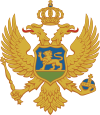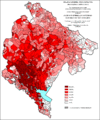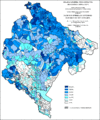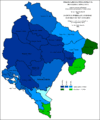- Controversy over linguistic and ethnic identity in Montenegro
-

This article is part of the series:
MontenegroSee also: Portal:Politics
An ongoing controversy exists over the national identity and name of the native language of the main ethnic group in the Republic of Montenegro. The issue more frequently disputed is whether Montenegrins constitute a subgroup of Serbs or a separate ethnic group. While there is wide agreement about the existence of a common language, the controversy persists about the use of the term "Montenegrin language" in certain political contexts.
Contents
History
Montenegro was part of medieval Serbia during 13th century and first half of the 14th century. Ottoman conquest of the Balkans resulted in separation from Serbia and re-emergance of Zeta. In the 19th century national romanticism among the South Slavs fueled the desire for re-unification.
- During Petar I Petrović Njegoš's reign, the basic textbook in state schools was called "The Serb elementary reading book". Another edition was published during Petar II Petrović Njegoš's rule;
- King Nicholas said : "Who isn't loyal to Montenegrinism, he won't be accepted by God and people"
- During the reign of Danilo II Petrovic Njegos, the pupils had classes in Serbian Grammar; Serbian History; and Slavic History.
- The geography syllabus at the College of Theology consisted of "studying the Serb lands independent, subjugated and occupied as well as the main cities, places and villages in the entire Slavhood".
- The geography textbook for the 3rd grade of elementary school, in 1911, said:
-
- In Montenegro live only true and pure Serbs who speak the Serbian language... Besides Montenegro there are more Serb lands in which our Serb brothers live... Some of them are as free as we are and some are subjugated to foreigners.[1]
- The 1909 census, undertaken by the Principality of Montenegro, recorded that 95% of the population spoke Serbian and followed the Orthodox Christian faith.[2]
Present situation
The political rift in late 1990s caused the Montenegrin/Serb ethnic issue to resurface.
The population of Montenegro is presently roughly divided on ethnic and political issues between the group composed of the ethnic Montenegrins (Orthodox, Muslim and Catholic), ethnic Bosniaks, ethnic Muslims, ethnic Croats and Albanians on one side, and the group composed of the ethnic Serbs on the other.
A number of Montenegrins living outside of Montenegro, primarily in Serbia, still maintain the Montenegrin folklore, family ties and clan affiliation. They remain Montenegrins by these standards, yet at censa they declare themselves mostly as Serbs. Some have risen to high cultural, economic and political positions and are widely known as Serbs while few know that they are of Montenegrin roots. For example, even Slobodan Milošević was a Serb of Montenegrin descent, the first generation of his family to be born in Serbia. His daughter, Marija Milošević, and his brother, the former ambassador to Russia Borislav Milošević, declare themselves ethnic Montenegrin.
Other prominent Serbs descending from partly or fully from Montenegro include linguist and major reformer of modern Serbian language Vuk Karadžić, revolutionary leader and founder of the Karađorđević dynasty Đorđe Petrović (most notably Aleksandar Karađorđević), first Serbian modern monarch and founder of the Obrenović dynasty Miloš Obrenović, notable Balkanologist and geographer Jovan Cvijić; Serbian monarchist politician and one time opponent of Milosevic in the Federal Republic of Yugoslavia, Vuk Drašković; the wartime leader of the Bosnian Serbs Radovan Karadžić,[3] current democratic President of Serbia Boris Tadić,[4] assassinated warlord Željko Ražnatović-Arkan who was only half-montenegrin,[5] famous poet and writer Matija Bećković, editor-in-chief of high circulation Večernje novosti daily Manojlo Vukotić, former basketball star Žarko Paspalj, current BIA chief Rade Bulatović, Serbian Interior Minister Dragan Jočić[1], Serbian constitutional court president Slobodan Vučetić[2], and half-montenegrin actress Milla Jovovich.[6]
Supporters
Various notable people in Montenegro supported Montenegrin independence and acknowledge the right of citizens in Montenegro to declare themselves as ethnic Montenegrins. Noted supporters of independence include famous statesman Milo Đukanović and the Speaker of Montenegro's Parliament Ranko Krivokapić. Of the minorities, these include the historical scientist Šerbo Rastoder (a Bosniak from Berane), don Branko Sbutega (a Roman Catholic priest from Kotor, declared as a Croat, who died April 27, 2006), and journalist Esad Kočan.
A number of notable Montenegrins include famous football players Dejan Savićević, Predrag Mijatović, Stevan Jovetić and Mirko Vučinić, politician Slavko Perović , Filip Vujanović, Jusuf Kalamperović declared as a Montenegrin who professes Islam, comedian Branko Babović, Sekula Drljević, popular folk singer Sako Polumenta, former world kick-boxing champion Samir Usenagić, actor Žarko Laušević, fashion model Marija Vujović, members of the rock group Perper, Miraš Dedeić, Montenegrin ruler Ivan I Crnojević and former President of Serbia and Montenegro Svetozar Marović.
Ethnic group name
Language
Religion
References
- ^ http://www.njegos.org/heritage/educat.htm
- ^ Demographic history of Montenegro
- ^ BBC: Profile: Radovan Karadzic
- ^ Kurir, June 30, 2004:Vojislav Koštunica (his grandfather surname was Damjanović , from Katunska nahija) Veselin konjevic: O'kle je Boris
- ^ IWPR: Milka Tadic: Arkanova Crnogorska Veza
- ^ Glas Javnosti, July 17, 2000: Koreni iz lepih Vasojevića (an interview with Milla's father)
Wikimedia Foundation. 2010.





